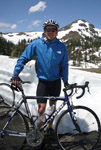
$220 SAVE $130 = 37.0% Western Digital 16.0TB Western Digital Ultrastar DC HC550 3.5-in… in Storage: Hard Drives
|

|

|

|

|
Training Strategy
Related: body fat, Everest Challenge, hard core, metabolism, Rides, training
I started training seriously on Dec 31, 2010 for the Everest Challenge, after a multi-year break, with a weight of about 202 pounds, which is at least 20 pounds too heavy (feels like crap also).
The Everest Challenge vertical ascent of 29,000+ vertical feet in two days means that every extra pound translates into 2-3 minutes extra time over the course of the race. Not to mention muscle fatigue and knee comfort and possibly finishing at all.
Initial strategy — January / February
Initial training strategy is simple: burn as many calories as possible so long as the workout level can be maintained. Reducing body fat feels good, and makes ascents a lot more manageable.
For January, that meant burning about 1200 calories per day every day of the week. I observed some loss of sustainable average power (watts) at times, indicating that the load is a bit ambitious and recovery was incomplete, suggesting that making one day per week a lower effort day or rest day could be prudent.
Early February saw a cold with hacking cough, which killed off some training days, but also provided an opportunity for a short rest period. Training to resume at the same level, then cautiously increasing the load by 10-20% if recovery allows for it.
The challenge at this stage is good diet, plenty of sleep, all while pushing to burn calories to get the weight down. A power meter (watt meter) is very helpful in gauging recovery.
Intermediate strategy — March / April
Physical condition after two months of training should now be reasonably good, and so the training load can be increased by adding one 2-3 hour ride on the weekend and by increasing daily average ride length by 25% or so.
Continued emphasis on dropping body fat while retaining existing muscle though high quality nutrition.
Incorporate one early century ride, the Hamilton Challenge.

Strength building — May / June
Close attention to weight loss must continue, but now with all systems fortified with 4 months of steady training making a solid fitness base, muscle strength must be increased, to lay a base for the raw power necessary for maintaining high average wattage.
Strategy: free squats with Olympic bar, crunches, upper body free weights: lat pull downs, bicep curls, bench press, with an emphasis on repetitions for the first month, to allow ligaments and tendons to adapt.
Over time, increase leg strength by moving to heavier squats: 100 repetitions X 135 pounds using Olympic bar twice per week. Moving to 35-50 repetitions at 220 pounds as season progresses.
Incorporate at least one century or similar ride per month into training schedule.
June
Heavy snow in 2011 means passes will open late in the Sierra, but sometime in June, ride most of the Everest Challenge ascents to re-familiarize with the course.
Special attention to the Schulman Grove climb from Big Pine, and the South Creek climb, the two last and hardest climbs on each day. Also, the psychologically challenging Glacier Lodge climb.
Special emphasis on pushing body fat below 10% by careful attention to diet.
Race specific training — late July / August / Sept
Move to race pace for training. Most rides to be done at race-pace heart rate and power output, e.g. aim for 82% max HR watts with rides up to 3 hours.
In late July, perform 10 X 1200 foot ascents, repeat twice in August, to simulate most of the vertical gain in the Everest Challenge.
Re-ride all race ascents in late August to re-familiarize with the course. Make sure heat tolerance is now excellent, since the race can be very hot.
Push body fat to 7-8% by careful attention to diet without losing any muscle. Target weight of 172 pounds.
Taper — September
Continue training in early September, including reality check by doing one day with at least 12,000' of vertical gain as 10 X 1200 foot ascents.
Taper as race approaches.
Seagate 22TB IronWolf Pro 7200 rpm SATA III 3.5" Internal NAS HDD (CMR)
SAVE $100



